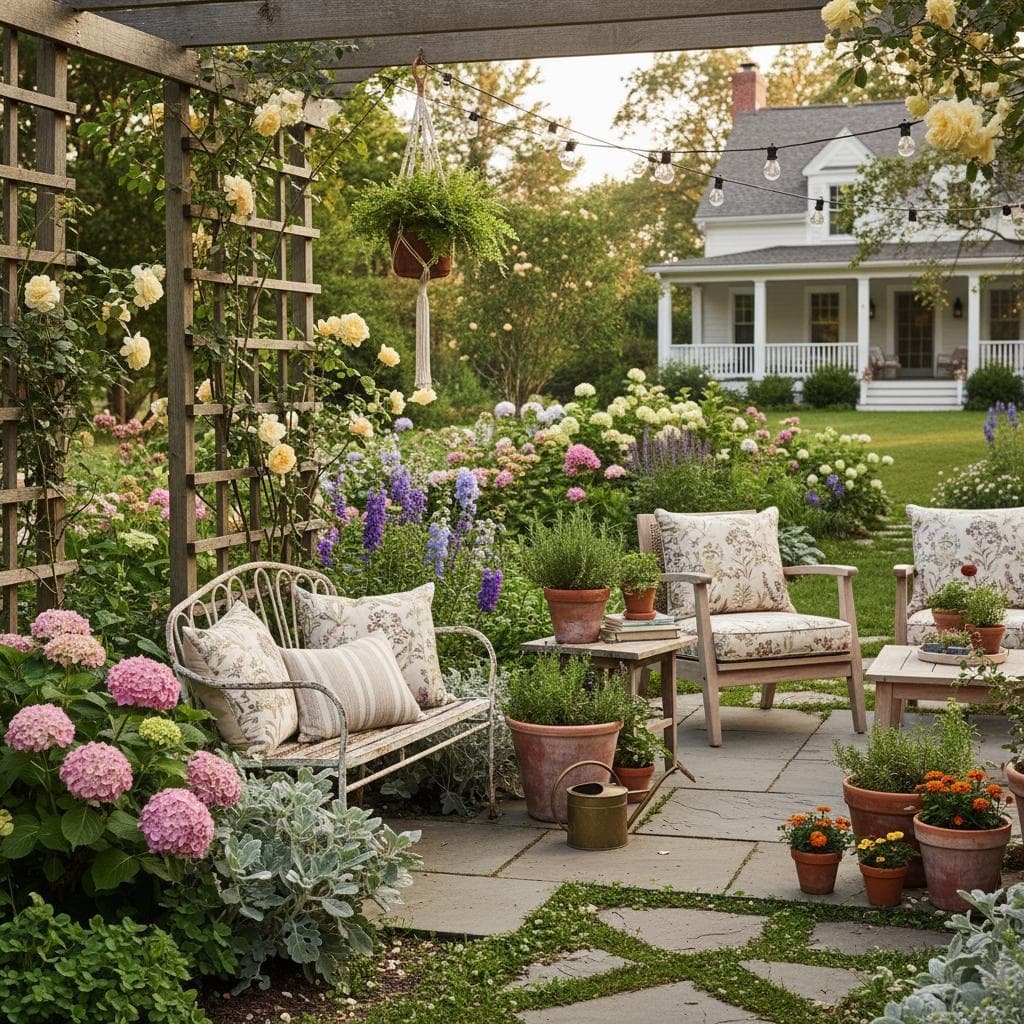Why Grandmillennial Gardens Define 2025 Outdoor Spaces
A garden that evokes a sense of enduring presence offers profound comfort. Consider the transition from a compact urban apartment to a countryside retreat, where established plantings of peonies, lavender, and rambling roses create an immediate feeling of continuity. This quality lies at the core of the grandmillennial garden, a design philosophy that revives classic cottage elements while aligning with contemporary lifestyles.
Grandmillennial gardens draw from historical English landscapes, yet they adapt seamlessly to diverse settings. Designers emphasize abundance and intimacy, ensuring each space reflects personal history rather than fleeting fashion. In 2025, this approach gains prominence as individuals seek refuge from streamlined, impersonal environments.
Essential Characteristics of Grandmillennial Design
- Heirloom Blooms: Select perennials such as foxgloves and delphiniums for their historical appeal and resilience.
- Layered Textures: Combine tall shrubs, mid-level herbs, and low-growing ground covers to build depth.
- Vintage Accents: Incorporate aged metal benches or salvaged pottery to enhance patina and narrative.
- Curved Pathways: Use winding gravel paths to encourage exploration and soften formal lines.
These components create environments that evolve naturally, rewarding observation with seasonal surprises.
Embracing Nostalgia Amid Contemporary Demands
Following decades of austere modernism, a shift toward tactile richness emerges. Professionals observe that busy schedules amplify the desire for resilient, welcoming gardens. Grandmillennial designs fulfill this need through forgiving layouts that integrate classic flora with practical simplicity.
Visualize lush hydrangea clusters adjacent to timeworn clay vessels, complemented by rattan seating and patterned textiles. Garden expert Clara Hughes notes that individuals seek "romance and roots." She further explains that the style "feels familiar, even when newly planted." Such resonance stems from its focus on evoking shared heritage rather than imposing novelty.
To incorporate this in daily life, start with modest additions. Plant lavender borders along walkways for subtle fragrance, or position antique lanterns to illuminate evening gatherings. These touches build emotional layers without overwhelming maintenance.
Core Elements That Shape the Style
Abundance forms the foundation of grandmillennial gardens. Vertical interest arises from perennials like hollyhocks and delphiniums, which tower gracefully. Planting beds feature dense mixtures of culinary herbs, trailing vines, and blooming understory plants, fostering biodiversity.
Color selections favor gentle hues: pale pinks, ivory tones, and verdant foliage, punctuated by vibrant notes of crimson or lavender. Furnishings prioritize durability and charm, such as forged iron seats or reclaimed wooden arbors. These details infuse the space with individuality, turning it into a canvas for personal expression.
For urban applications, scale elements appropriately. On a balcony, arrange vintage enamelware containers with rosemary and thyme, then drape a heritage fabric over a side table. This method preserves rural essence while accommodating limited square footage, proving the style's versatility.
Integrating Sustainability with Timeless Appeal
Nostalgic visuals pair with eco-conscious strategies in grandmillennial gardens. Native plants and those attracting pollinators dominate selections, supporting local ecosystems. Practices like organic mulching, water conservation, and material recycling underpin the design.
Landscape specialist Tomas Reed highlights that the appeal "lies in its restraint and sustainability." Gardens develop organically over seasons, minimizing intervention. Homeowners benefit from reduced upkeep, as robust species thrive with minimal irrigation or chemicals.
Practical steps include installing rain barrels for collection and choosing drought-tolerant natives like salvia or echinacea. These choices not only honor tradition but also promote environmental stewardship, ensuring longevity in varied climates.
Practical Steps to Cultivate Your Own Grandmillennial Garden
Begin by assessing your site: measure sunlight exposure and soil type to select compatible plants. Source heirloom seeds from specialty nurseries, focusing on varieties suited to your region. Prepare beds with compost-enriched soil to encourage healthy root systems.
Next, layer plantings strategically. Position taller specimens at the rear, followed by mid-height fillers and edging ground covers. Introduce hardscape elements gradually, such as a stone bench or trellis, to frame views and provide seating.
Maintenance involves seasonal tasks: prune in early spring, deadhead spent blooms, and refresh mulch annually. Monitor for pests using natural remedies like neem oil. Over time, these routines transform the space into a lived-in haven.
The Lasting Rewards of a Grandmillennial Retreat
As a grandmillennial garden establishes itself, it weaves into household routines. Savor morning beverages amid rose arches, host informal suppers beneath jasmine canopies, or dedicate afternoons to gentle tending. Even compact installations, like window ledges with potted herbs, cultivate similar tranquility when thoughtfully arranged.
This design philosophy welcomes organic growth and personal stories. It underscores that genuine allure arises from familiarity and care. In an era of constant motion, such gardens provide steadfast anchors, inviting reflection and renewal within the embrace of home.




